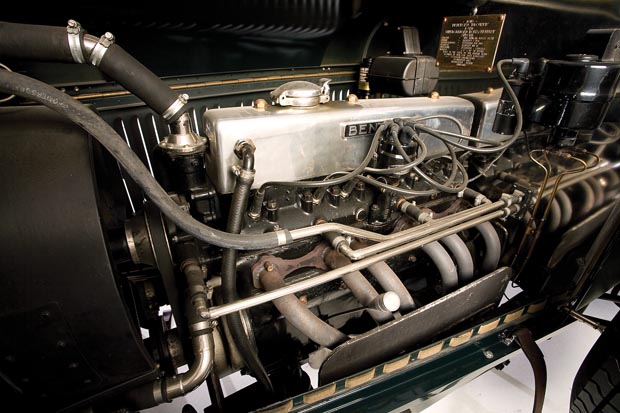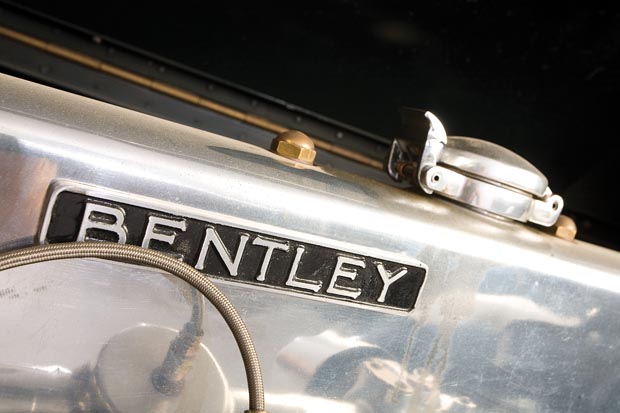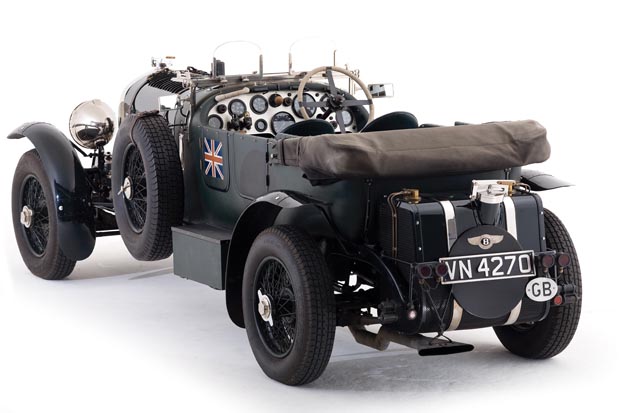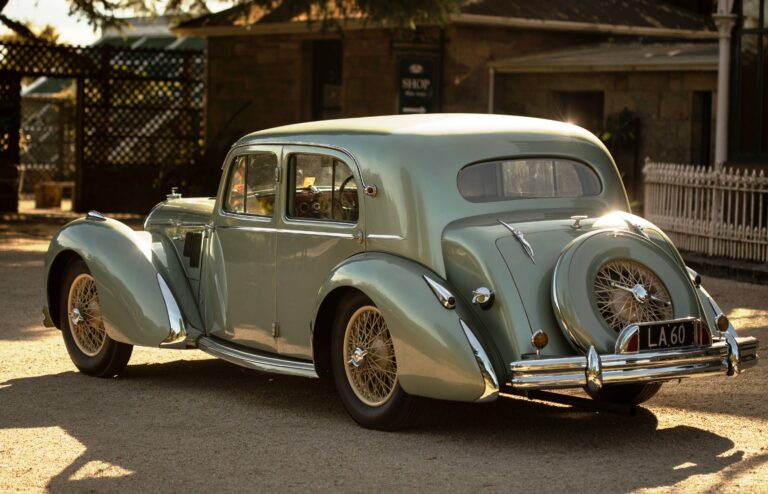data-animation-override>
“Published in New Zealand Classic Car Issue No. 211”

Several years ago we printed a short story on this car. Since then it has changed ownership, allowing us to take a much closer look at this re-creation of the legendary Blower Bentley
We’ve all had the opportunity to either drive or be taken for a ride in something that practically alters the entire way we view our own automotive passions: making us realise that there’s a lot more, in fact, a hell of a lot more to this hobby than what we know, or indeed think we know.
There’s nothing that quite excites the emotions more on a foggy Auckland Saturday morning than to be taken for a spin around an inner city suburb in a ‘1932’ Blower Bentley. It may be a re-creation but don’t be fooled; this Peterson-built special is as close to the real thing as you’re ever going to see and, unless you go delving into the bowels of this superb piece of engineering brilliance to literally check the chassis number, basically there’s no evidence to suggest otherwise.
This car oozes character from beneath every handcrafted rivet to its green Wilton carpet and Connolly leather upholstery and, as I climbed aboard the huge beast, the hairs on my neck were standing on end at the thought of what I was about to experience. The breathtaking sound of the massive 4.5-litre supercharged engine was like nothing I have ever heard before. To say this thing was built like a Sherman tank would be an understatement, and looking around the cockpit, it seemed clearly obvious that the creator of the original Bentley, WO Bentley, started out as a locomotive engineer. Once a few minor issues like a flat battery and overheating issues at idle were sorted we headed off. This big old girl likes plenty of cool air in her face to keep operations at optimal temperature.
Powerful monster
In the Bentley, you’re sitting perched above the drivers of cars and most SUVs, and one of my first feelings was how big this car really is and, though it’s beautifully proportioned, that gave way to the fact that everything is just¦ BIG!
Naturally, there was so much going on in my mind I was trying to take everything in at once — which included observing David Blackmore, the beast’s owner, wrestle this immensely powerful monster around suburban streets. Every stop, intersection and manoeuvre required precise coordination and timing between double declutching, reaching awkwardly down between the seat and the drivers’ door for the gear shift, selecting the right gear, keeping the revs up, operating the massive, seemingly unpredictable, ventilated drum brakes and guiding the car with some trepidation by yanking the steering wheel from time to time. It all made for a very exciting ride. I could see that our particular model was equipped with the ‘arm-strong’ variable steering option ranging from virtually impossible at rest to not much better at speed. Of course, there are no crumple zones or airbags aboard this puppy. Hit something and you’re likely to go straight through it, or if it were solid enough then the big Bentley would more than likely come to an abrupt stop, leaving its occupants somewhat vulnerable.
The machine-turned aluminium dash layout fitted with large aircraft-type instruments on the Bentley are less than ergonomically efficient to say the least, with a bewildering array of dials and switches which I scanned on more than one occasion in an attempt to find out what was going on. Funnily enough, even David wasn’t too sure what some of the switches were for either.
I found myself unable to wipe the silly grin off my face as I tried to imagine the antics of the infamous Bentley Boys in the late 1920s, and I sensed a real appreciation for the courage, bravery and commitment it must have taken to actually race one of these cars. It’s been said before, but there are moments in time that remain indelibly etched in one’s mind forever. For me, this is one of those great experiences that will remain with me for a very long time.
The Bentley Trust
Being the trustee of a trust that goes by the name The Bentley Trust — trading under the name Number One Limousines — can have its advantages, especially if you happen to be a passionate car enthusiast. When successful businessman and property developer, David Blackmore, decides to add another vehicle into the trust’s fleet then anything can happen. What I’m really trying to say is that David has no real affinity to any one marque, so basically, if he likes the look of it, and the price is right, chances are it’ll be snapped up.
Mind you at the moment Bentleys seem outnumbered by the others cars in the trust’s collection — which include Rolls- Royces (one of them a new model Phantom), Lincolns, Cadillacs, Lamborghinis, a Buick Riviera, a Corvette, a couple of Dodge SRT10s, no less than half a dozen Mercedes-Benz Pullmans (two of which were previously owned by Hugh Hefner while another is a rare Landaulet model). There is even a Messerschmitt. I’m sure I’ve missed a few, however, luckily for me, one of David’s new building projects — currently under construction and which will eventually house the entire fleet — is literally just around the corner from NZCC HQ. So as you can imagine my visits are frequent, and David is always kind enough to stop and take time out to chat about the cars.
An expensive bargain
About 18 months ago, David was visiting a local prestige car dealership, and sitting in the showroom was the 1932 Peterson Blower Bentley you see here is these pages.
“I thought this car was absolutely fabulous,” David told me, and although he had never heard of Peterson, he quickly learned that this re-creation was going to cost a fraction of a real Blower Bentley. At that point it was a no-brainer, although he admits it was an expensive bargain.
This Bentley represents the finest workmanship available today, and is one of a special order of six cars built by Peterson under instruction from none other than Barclays of London, one of the world’s most renowned Bentley dealers. These six cars were the result of many years of creative re-bodying, rebuilding and restoring the minimal fleet of original cars that were actually built by WO Bentley during the model’s 10 years of production. Mounted prominently on the firewall, the finely embossed brass plate clearly states it all — “Peterson Blower. 4.5-litre supercharged Rolls/Bentley Special” and concludes with, “Built in the Style of the Birkin Team Blower Of 1930 for Jack Barclays — Peterson Engineering.”
It was built on a Rolls-Royce chassis, and the idea was to use authentic Bentley and Rolls-Royce components from the ’20s and ’30s to recreate the famous 1929—1931 4.5-litre supercharged Le Mans Bentley in the exact style of the great racing Bentleys. This Bentley looks the part in every respect, right down to the officially authorised, registered Bentley trademark badges front and rear and the unmistakable, specially built blower similar to the Amherst Villiers unit used by the Birkin racing team.
The Beginning
Bentley Motors Limited, a British-based manufacturer of luxury cars and Grand Tourers was founded on January 18, 1919, by Walter Owen Bentley, known simply as WO.
In his formative years WO was trained as a locomotive engineer, and his youthful enthusiasm enabled him to enjoy cricket and motorcycle racing — which included racing a 3.7kW (5hp) Rex at Brooklands in 1909.
After his time at the railway WO joined his brother, HM Bentley, selling French DFP cars which were hardly renowned for their performance — that is, until WO appeared on the scene. He soon improved their performance by using lighter pistons made from copper and aluminium. With this new-found technology, plus Bentley’s redesigned camshaft, DFPs won several races at Brooklands, taking out class B records in 1913 and 1914.
During WWI, WO worked for the technical board of the Royal Naval Air Service perfecting the French Clerget rotary engine, and his experience in using aluminium
pistons was to prove invaluable. These modified engines soon bore his name, being called the BR1 and BR2 (Bentley Rotary). After the war WO’s ambition was to see a car bearing his own name, thus encompassing his knowledge and experience from previous years, and in 1919 he formed Bentley Motors Limited.
Bentley existed in its original guise for just over a decade, yet the company’s accomplishments in that time were astonishing. During the its early years the focus was entirely on motorsports, culminating in four consecutive victories at the Le Mans 24 Hour Race, the world’s most prestigious race and one in which the emphasis was on endurance and reliability rather than how quickly the cars finished. The key to the race was to actually finish.
The Bentley Boys
The car’s reputation for high performance was kept alive and well by a group of prosperous British car enthusiasts known as The Bentley Boys — Woolf Barnato, heir to a partnership in the Kimberly diamond mines; Sir Henry Birkin; George Duller, steeplechaser; Glen Kidston, aviator; Sammy Davis, automotive journalist; and Dr Dudley Benjafield.
The Bentley Boys captured the spirit of the times, partying as hard as they worked. Larger than life, their restless and often reckless love of speed and adventure perfectly complemented the big green Bentleys from Cricklewood. More than a few of them resided in Grosvenor Square, in adjoining flats, and it soon became known as Bentley Corner given the number of Bentleys often parked there.
At one point, on a bet, Barnato raced a legendary Bentley against the Blue Train Express across France, travelling on public highways with normal traffic from Cannes to Calais, then by ferry to Dover, finally arriving in London as the train arrived in Calais. He won, and the special-bodied 6.5-litre car became known as the Blue Train Bentley.
The first racers
WO’s design philosophy followed a simple formula. “We were going to make a fast car, a good car, the best in its class.” This idea lay behind all the cars produced by Bentley Motors, an idea the value of which was proved through motor racing. WO’s motor racing goals were equally straightforward. It was undoubtedly the most cost effective way of proving and subsequently testing his designs, and was the most successful way of advertising the cars.
Bentley’s first race-prepared car was designated Exp2, earning its first victory at Brooklands in 1921, a sprint race won by works driver, Frank Clement. This victory highlighted the reputation of the new car design, justifying Bentley’s participation in motor sport. This prototype vehicle still exists, and is owned by Bentley.
Bentley was represented by chassis #141 — a 3.0-litre driven by John Duff, a Bentley dealer based in London — at the original running of the Le Mans race in May 1923. The car finished fourth, delayed in large part by mechanical problems, but it returned in 1924 to win the first victory for Bentley.
The next Bentley to win at Le Mans was ‘Old Number 7,’ in 1927, following a shocking crash that left the two other Bentleys out of action for the duration of the race. Number seven was seriously damaged, but eventually caught and passed the lead car to claim victory.
Bentley Boy Sir Henry Birkin had, at this point, become an accomplished Bentley racer and he won at Le Mans in 1929, but he was significant to the Bentley story for another reason. It was his suggestion to supercharge the hefty Bentleys to overcome their immense size and weight disadvantage on the track. Although unconvinced at first, WO was eventually persuaded to fit a supercharger, giving birth to the classic Blower Bentley. Initially unreliable, it went on to become a motoring icon with its distinctive front-mounted supercharger.
Birkin met an unfortunate end in 1933, dying from complications after being burned by the hot exhaust of his Maserati during a refuelling stop at the Tripoli Grand Prix. WO realised the publicity motor racing success would generate, and enthusiastically encouraged it, commenting that, “The company’s activities, particularly its racing, attracted the public’s fancy and added a touch of colour, vicarious glamour and excitement to drab lives.”
The most famous and valuable of all the Bentley racing cars is the 8.0-litre Speed Six, ‘Old Number One’. This car has an illustrious history, recording two consecutive Le Mans victories, and it made a huge impact by winning Brookland’s 500-mile race in 1931.
Clive Dunfee crashed this car at Brooklands in 1932, unfortunately losing his life. Following the crash, Old Number One became an almost mythical beast in the motor racing world. A high profile court case took place in 1990 which determined that the car did still exist — although extensively rebuilt with other parts it changed hands for an amazing £10 million.
The Great Depression was particularly hard on luxury car manufacturers, and by 1931 Bentley was having financial difficulties that couldn’t be solved by winning races alone. That same year Bentley became a subsidiary of Rolls-Royce, which clearly had little to do with racing cars.
With a reduced customer base, it made sense for Rolls-Royce to do away with its top competitor and, after the purchase, Bentley racing was largely confined to private teams, with factory backing at an absolute minimum. It should be noted that Bentley was a very serious competitor to Rolls-Royce, and that the 8.0-litre Bentley was probably a better machine than anything Rolls-Royce had to offer at that time.
Bob Petersen Engineering
Petersen Engineering, based in rural Devon, has forged a name for itself worldwide through over 25 years of restoring, rebuilding and recreating Bentleys, utilising the vast inventory of replacement parts manufactured on site. The reasons for owning a Petersen Special are as diverse as the owners themselves. They include reliability, safety and compatibility with the demands of modern traffic, price, and quality of finish. Quite apart from today’s vintage Bentley prices, numerous potential buyers are typically well aware of their own driving limitations and have no desire to take part in all the tall stories of difficult gearboxes and narrow misses with poor brakes.
Using period parts built to authentic coachwork patterns and dimensions of cars of the ’20s, Petersen Specials are classic recreations, therefore not ‘original’ in the strictest sense of the word. Petersen Engineering cars are built on original ’30s Bentley or Rolls-Royce 20/25 chassis and supplied with an original registration number and documents. New bodywork, windscreen, footplates, exhausts and other parts are to be found on many restored ‘original’ Bentleys, supplied in many cases by Petersen Engineering.
The Petersen 4.5-litre Blower is an authentic re-creation of the charismatic car developed for racing by Sir Henry Birkin and his team in the late ’20s.
All its components are completely reconditioned to the highest standards. Many of the fittings are hand made, including filler caps, stone guards, footplates, fuel tanks, radiators, wheels, hubs, superchargers, bodies, trim and dashboard, as well as many other smaller parts.
As suggested earlier, WO Bentley himself was not very keen to see his cars supercharged, fearing they would be unreliable. Bob Peterson Engineering feels the Petersen Blower would have met his approval, especially if the reactions of satisfied customers are anything to go by. Acceleration, performance and speed are breathtaking, and in combination with the powerful whine of the supercharger to complement the guttural exhaust, a spectacular entrance to any event is guaranteed.
Specs
Peterson 4.5-Litre ‘Blower’ Bentley
Engine: Straight-six Bentley R-Type fitted with special camshafts, pistons and flywheel
Capacity: 4.5-litre, supercharged
Max power: 175kW-plus
Gearbox: Four-s
peed manual, modified MkVI Bentley fitted with Laycock/Peterson ‘P’ Type overdrive providing 26 per cent increase in fourth gear and Peterson heavy duty clutch
Chassis: Rolls-Royce, strengthened to Bentley specifications. New cross members and suspension mounts to accommodate supercharged motor
Front/rear axle: Royce 20/25
Brakes: Power-assisted servo hydraulic 17-inch diameter racing drums with twin leading shoe system on front. Rear — 14-inch drum
Wheels/tyres: 700×19-inch 70 spoke wire wheels with 700×19-inch tyres
Body: Vanden Plas Le Mans style. Ash frame, aluminium skin, fabric covered
Words Ashley Webb Photos Adam Croy




















